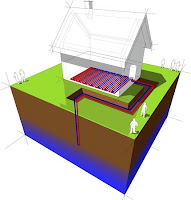Because they’re extremely energy efficient and
environmentally friendly, geothermal heat pumps have become increasingly
popular in the last couple of decades. Many log home owners find that
geothermal heat pumps are a great way to keep energy bills low while keeping
their homes at a comfortable temperature all year round. Before you commit to a
geothermal installation, however, some research is in order. Today we’ll weigh
the pros and cons of geothermal heat.
In Favor of Geothermal Heat
As we’ve already mentioned, geothermal heat pumps are
remarkably energy efficient. Rather than relying on the burning of fossil
fuels, geothermal heat systems work in much the same way that a refrigerator
does, using a series of liquid-filled coils to draw underground heat up into
your home. Once the heated liquid rises above ground level, it’s distributed
throughout your home with a blower and ductwork. Rather than creating a new
heat source, a geothermal system simply moves nearby heat from the inside of
the earth to your home. Geothermal systems are also quiet and low maintenance
because there are very few moving parts involved.
Drawbacks of Geothermal Heat
The first thing that usually deters homeowners from getting geothermal
heat is the installation cost. This initial investment may cost anywhere from
$10,000 to $30,000 dollars. It will
increase your home’s resale value and significantly lower your energy bills,
but unless you’re planning on staying in your home for a number of years in the
future the cost of installation can be a bit hard to swallow. The installation
also requires a considerable amount of digging and drilling in your yard. The overall
difficulty of installation will depend on your locale and soil conditions.
Want to learn more about geothermal heating? Check out this helpful guide
from the U.S. Department of Energy.


